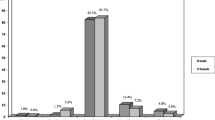Abstract
This study compares non clinical subjects from the Czech Republic and Germany regarding their eating behavior and attributes they associate with female role models. We assessed Czech and German students and their mothers, 328 subjects in total, by having them complete 2 questionnaires related to weight, eating behavior, as well as different role models (a professionally successful woman, a good mother, etc.). The female Czech students had a lower ideal BMI than the German female students, and were more dissatisfied with their bodies. Thus, the higher drive for thinness in the Czech students could be an indicator for an increased risk regarding eating disorders. Regarding role models, the Czech results were very different from those of the Germans. The Czech women characterized female roles more with items like following own goals, competent in job, competing. The more professional female role description in the Czech Republic reflects the tradition of working women in former socialist states. But the relationship between eating behavior and gender roles remains unclear.
Similar content being viewed by others
References
Lawrence M.:“Ich stimme nicht”: Identitätskrise und Magersucht. Reinbek, Rowohlt, 1986.
Gerlinghoff M., Backmund H., Mai N.: Magersucht- Auseinandersetzung mit einer Krankheit. Weinheim, Psychologie Verlags Union, 1988.
Vandereycken W., van Deth R., Meermann R.: Hungerkünstler, Fastenwunder, Magersucht: eine Kulturgeschichte der Eßstörungen. Zülpich, Biermann, 1990.
Banks C.G.: “Culture” in culture-bound syndromes: the case of anorexia nervosa. Soc. Sci. Med., 34, 867–884, 1992.
Lee S.: Self-starvation in context: towards a culturally sensitive understanding of anorexia nervosa. Soc. Sci. Med., 41, 25–36, 1995.
Catina A., Boyadjieva S., Bergner M.: Social context, gender identity and eating disorders in western and eastern Europe: preliminary results of a comparative study. Eur. Eat. Disord. Rev., 4, 100–106, 1996.
Krch F.D.: Poruchy příjmu potravy: vymezení a terapie. Grada, Praha 33–56 (Czech), 1999.
Steinhausen H.C., Boyadjieva S., Grigoroiv-Serbanescu M., Seidel R., Winkler Metzke C.: A transcultural outcome study of adolescent eating disorders. Acta Psychiatr. Scand., 101, 60–66, 2000.
Miller M.W., Pumariega A.J.: Culture and eating disorders: a historical and cross-cultural review. Psychiatry 64, 93–110, 2001.
Rathner G., Túry F., Szabó P.: Eating disorders after the political changes in the formerly community eastern- european countries. Orv. Hetil., 142, 1331–1333, 2001.
Garfinkel P.E., Garner D.M.: Anorexia nervosa: a multidimensional perspective. New York, Brunner/Mazel, 1982.
Wiseman C.V., Gray J.J., Mosimann J.E., Ahrens A.H.: Cultural expectations of thinness in women: an update. Int. J. Eat. Disord., 11, 85–89, 1992.
Andersen A.E., Di Domenico L.: Diet vs. shape content of popular male and female magazines: a doseresponse relationship to the incidence of eating disorders? Int. J. Eat. Disord., 11, 283–287, 1992.
Krch F.D.: Growing Czech awareness of eating disorders. BASH Magazine 11, 314–321, 1989.
Plháková A., Míčková J.: Rozdíly v percepci tělesného schématu mezi muži a zženami. Česká a Slovenská Psychiatrie, 96, 310–315, 2000.
Janout V., Kollárová H., Němečková P.: Rizikové faktory u poruch příjmu potravy — průrřezová epidemiologická studie. Česká a Slovenská Psychiatrie 97, 350–355, 2001.
Krch F.D., Drábcková H.: Prevalence mentální anorexie a bulimie v populaci české mláde že. Česká Slov. Psychiatr., 92, 237–247, 1996.
Krch F.D.: Epidémiologie des troubles des troubles des conduites alimentaires en Tchécoslovaquie. Neuropsychiatrie de l’enfance et de l’adol 39, 311–322, 1991.
Němečková P., Zatloukalová M., Bouček J., Musilová S. Půlro ční zku šenosti s provozem Jednotky pro léčbu poruch příjmu potravy. Česká a Slovenská Psychiatrie 95, 472–475, 1999.
Rathner G., Túry F., Szabó P., Geyer M., Rumpold G., Forgács A., Söllner W., Plöttner G.: Prevalence of eating disorders and minor psychiatric morbidity in Central Europe before the political changes in 1989: a cross-cultural study. Psychol. Med., 25, 1027–1035, 1995.
Boskind-White M., White W.C.: Bulimarexia: The Binge/ Purge Cycle. New York, WW Norton, 1983.
Weeda-Mannak W.: Female sex-role conflicts and eating disorders. In: Dolan B., Gitzinger I. (Eds.), Why women? Gender issues and eating disorders. London, Athlone Press, 1995.
Klingenspor B.: Bulimarexia: Die Psychologie eines sozio-kulturellen Phänomens. In: Kämmerer A., Klingenspor B. (Eds.), Bulimie: zum Verständnis einer geschlechtsspezifischen Essstörung. Stuttgart, Kohlhammer, 1989, p. 71–87.
Klingenspor B.: Bulimisches Eßverhalten und Geschlechtsidentität bei Jugendlichen: Strukturmodelle mit nicht normal verteilten Variablen. (Dissertation, University of Heidelberg), 1991.
Gilligan C.: In a different voice. Cambridge, Harvard University Press, 1982.
Faltus F.: Bulimia nervosa. Československá Psychiatrie, 83, 365–375, 1987.
Joja O., von Wietersheim J.: Transkultureller Vergleich von Gewicht und spezifischen Essstörungen zwischen Rumänien und Deutschland. Psychother. Psychosom. Med. Psychol., 52, 95, 2002.
O’Keefe P., Lovell D.M.: Eating Disorder Inventory Scores in Russia and Britain: A preliminary comparison. Eur. Eat. Disord. Rev., 7, 129–135, 1999.
Krch F.D.: Being overweight and developing an eating disorder in the Czech Republic. Eating disorders. J. Treat. Prev., 3, 20–27, 1995.
Steinmann A.: Kulturelle Wertvorstellungen, Rollenerwartungen an die Frau und therapeutische Ziele: Forschung und Interpretation. In: Franks V., Burtle V. (Eds.), Frauen und Psychotherapie: Fragen- Probleme-Modelle. München, Pfeiffer, 1979, pp. 57–94.
Ratzke K.: Zur Analyse soziokultureller Bedingungen der Geschlechtsrolllenannahme am Beispiel gestörten Eßverhaltens: eine vergleichende Studie zwischen Studentinnen aus Ost- und Westdeutschland. Göttingen, Cuvillier, 1995.
Author information
Authors and Affiliations
Corresponding author
Rights and permissions
About this article
Cite this article
Pecová, V., von Wietersheim, J. Eating behavior differences and the perception of gender roles in Czech and German nonclinical samples. Eat Weight Disord 10, 83–90 (2005). https://doi.org/10.1007/BF03327529
Received:
Accepted:
Published:
Issue Date:
DOI: https://doi.org/10.1007/BF03327529




